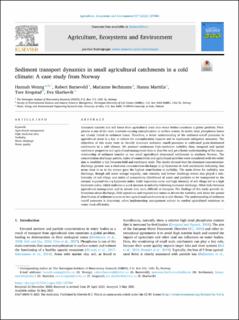| dc.contributor.author | Wenng, Hannah | |
| dc.contributor.author | Barneveld, Robert | |
| dc.contributor.author | Bechmann, Marianne | |
| dc.contributor.author | Marttila, Hannu | |
| dc.contributor.author | Krogstad, Tore | |
| dc.contributor.author | Skarbøvik, Eva | |
| dc.date.accessioned | 2021-07-21T07:41:52Z | |
| dc.date.available | 2021-07-21T07:41:52Z | |
| dc.date.created | 2021-06-09T20:38:44Z | |
| dc.date.issued | 2021-09-01 | |
| dc.identifier.citation | Agriculture, Ecosystems & Environment. 2021, 317 . | en_US |
| dc.identifier.issn | 0167-8809 | |
| dc.identifier.uri | https://hdl.handle.net/11250/2764851 | |
| dc.description.abstract | Increased nutrient and soil losses from agricultural areas into water bodies constitute a global problem. Phosphorus is one of the main nutrients causing eutrophication in surface waters. In arable land, phosphorus losses are closely linked to sediment losses. Therefore, a better understanding of the sediment-runoff processes in agricultural areas is a key to reduce the eutrophication impacts and to implement mitigation measures. The objectives of this study were to identify dominant sediment runoff processes in cultivated grain-dominated catchments in a cold climate. We assessed continuous high-resolution turbidity data, temporal and spatial catchment properties and agricultural management data to describe and get a better understanding of the cause-relationship of sediment transfer in two small agricultural dominated catchments in southern Norway. The concentration-discharge pattern, index of connectivity and agricultural activities were considered with the wider aim to establish a link between field and catchment scale. The results showed that the dominant concentration-discharge pattern was a clockwise concentration-discharge (c-q) hysteresis in both catchments indicating that areas close to or in the stream gave the highest contribution to turbidity. The main driver for turbidity was discharge, though soil water storage capacity, rain intensity and former discharge events also played a role. Intensity of soil tillage and index of connectivity (likelihood of water and particles to be transported to the stream) impacted the c-q hysteresis index. Little vegetation cover and high intensity of soil tillage led to a high hysteresis index, which indicates a quick increase in turbidity following increased discharge. Other links between agricultural management and in stream data were difficult to interpret. The findings of this study provide information about discharge, field operations and vegetational status as drivers for turbidity and about the spatial distribution of sediment sources in two agricultural catchments in a cold climate. The understanding of sediment runoff processes is important, when implementing management actions to combat agricultural emissions to water most efficiently. | en_US |
| dc.language.iso | eng | en_US |
| dc.publisher | Elsevier B.V. | en_US |
| dc.rights | Navngivelse 4.0 Internasjonal | * |
| dc.rights.uri | http://creativecommons.org/licenses/by/4.0/deed.no | * |
| dc.title | Sediment transport dynamics in small agricultural catchments in a cold climate: A case study from Norway | en_US |
| dc.type | Peer reviewed | en_US |
| dc.type | Journal article | en_US |
| dc.description.version | publishedVersion | en_US |
| dc.rights.holder | © 2021 The Author(s) | en_US |
| dc.source.pagenumber | 13 | en_US |
| dc.source.volume | 317 | en_US |
| dc.source.journal | Agriculture, Ecosystems & Environment | en_US |
| dc.identifier.doi | 10.1016/j.agee.2021.107484 | |
| dc.identifier.cristin | 1914928 | |
| dc.source.articlenumber | 107484 | en_US |
| cristin.ispublished | true | |
| cristin.fulltext | original | |
| cristin.qualitycode | 1 | |

